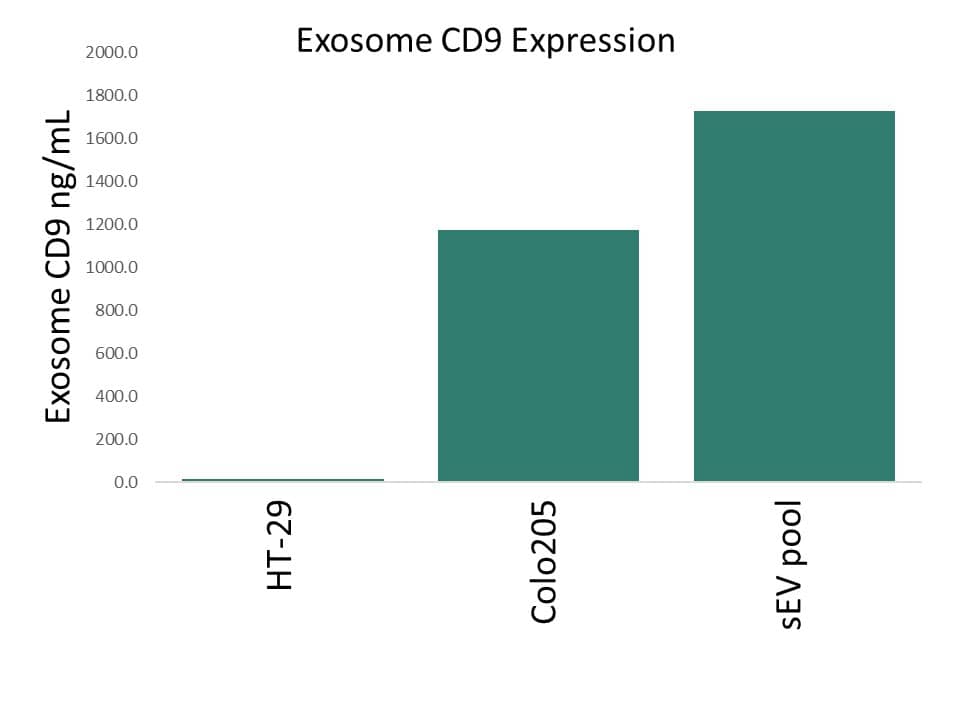Human CD9 Antibody
R&D Systems, part of Bio-Techne | Catalog # MAB10582

Key Product Details
Species Reactivity
Human
Applications
ELISA, Immunocytochemistry
Label
Unconjugated
Antibody Source
Monoclonal Mouse IgG1 Clone # 1021012
Product Specifications
Immunogen
Chinese Hamster Ovary cell line, CHO-derived human CD9
Ser112-Ile195
Accession # P21926
Ser112-Ile195
Accession # P21926
Specificity
Detects human CD9 in direct ELISAs.
Clonality
Monoclonal
Host
Mouse
Isotype
IgG1
Scientific Data Images for Human CD9 Antibody
Detection of CD9 in MCF-7 Human Breast Cancer Cell Line (Positive) and U937 Human Histiocytic Lymphoma Cell Line (Negative).
CD9 was detected in immersion fixed MCF-7 Human Breast Cancer Cell Line (Positive) and U937 Human Histiocytic Lymphoma Cell Line (Negative) using Mouse Anti-Human CD9 Monoclonal Antibody (Catalog # MAB10582) at 8 µg/mL for 3 hours at room temperature. Cells were stained using the NorthernLights™ 557-conjugated Anti-Mouse IgG Secondary Antibody (red; Catalog # NL007) and counterstained with DAPI (blue). Specific staining was localized to cell surface and cytoplasm. View our protocol for Fluorescent ICC Staining of Cells on Coverslips.Detection of Human CD9 in exosomes with Anti-Human CD9 Monoclonal Antibody in ELISA Assay.
The Human CD9 Antibody (Catalog # MAB10582) was conjugated with an affinity tag and incubated at 0.05ug/mL with culture media from HT29, COLO205 cell lines, and ultracentrifuge-enriched serum exosomes. HRP conjugated antibody was used as detection and incubated at 0.2ug/mL. The test was run on a microplate that was pre-coated with an anti-tag antibodyDetection of Human CD9 using Anti-Human CD9 Monoclonal Antibody in ELISA Assay.
Recombinant Human CD9 protein (10015-CD) was serially diluted and incubated with Human CD9 Antibody (Catalog # MAB10582) that was conjugated with an affinity tag at 0.05ug/ml. HRP conjugated antibody was used as detection, incubated at 0.2ug/mL. The test was run on a microplate that was pre-coated with an anti-tag antibody.Applications for Human CD9 Antibody
Application
Recommended Usage
ELISA
Detects CD9+ exosomes in direct ELISA.
Immunocytochemistry
8-25 µg/mL
Sample: Immersion fixed MCF‑7 Human Breast Cancer Cell Line (Positive) and U937 Human Histiocytic Lymphoma Cell Line (Negative)
Sample: Immersion fixed MCF‑7 Human Breast Cancer Cell Line (Positive) and U937 Human Histiocytic Lymphoma Cell Line (Negative)
Formulation, Preparation, and Storage
Purification
Protein A or G purified from hybridoma culture supernatant
Reconstitution
Reconstitute at 0.5 mg/mL in sterile PBS. For liquid material, refer to CoA for concentration.
Formulation
Lyophilized from a 0.2 μm filtered solution in PBS with Trehalose. *Small pack size (SP) is supplied either lyophilized or as a 0.2 µm filtered solution in PBS.
Shipping
Lyophilized product is shipped at ambient temperature. Liquid small pack size (-SP) is shipped with polar packs. Upon receipt, store immediately at the temperature recommended below.
Stability & Storage
Use a manual defrost freezer and avoid repeated freeze-thaw cycles.
- 12 months from date of receipt, -20 to -70 °C as supplied.
- 1 month, 2 to 8 °C under sterile conditions after reconstitution.
- 6 months, -20 to -70 °C under sterile conditions after reconstitution.
Background: CD9
References
- Shi, W. et al. (2000) J. Cell Biol. 148:591.
- Hemler, M. (2003) Annu Rev Cell Biol. 19:397.
- Hulme, R. et al. (2014) PLoS One 9:e116289.
- Stipp, C. et al. (2003) Trends Biochem Sci. 28:106.
- Barreiro, O. et al. (2005) Blood 105:2852.
- Ventress, J. et al. (2016) PLoS One 11:e0160387.
- Rubinstein, E. (2011) Biochem Soc Trans. 39:501.
- Anzai, N. et al. (2002) Blood 99:4413.
- Radford, K. et al. (1996) Biochem. Biophys. Res. Commun. 222:13.
- Lozahic, S. et al. (2000) Eur. J. Immunol. 30:900.
- Park, K. et al. (2000) Mol. Hum. Reprod. 6:252.
- Charrin, S. et al. (2001) J. Biol. Chem. 276:14329.
- Tachibana, I. et al. (1997) J. Biol. Chem. 272:29181.
- Zhu, G. et al. (2002) Development 129:1995.
- Green, L. et al. (2011) Infect Immun. 79:2241.
- Powner, D. et al. (2011) Biochem. Soc. Trans. 39:563.
- Detchokul, S. et al. (2014) British Journal of Pharmacology 171:5462.
- Reyes, R. et al. (2018) Front. Immunol. 9:863.
- Slupsky, J. et al. (1989) J Biol chem. 264:12289.
- Ishibashi, T. et al. (2004) J. Neuroscience 24:96.
- Kobayashi, H. et al. (2004) Clin Exp Immunol. 137:101.
Alternate Names
CD9, DRAP-27, MIC3, p24, TSPAN29
Gene Symbol
CD9
UniProt
Additional CD9 Products
Product Documents for Human CD9 Antibody
Product Specific Notices for Human CD9 Antibody
For research use only
